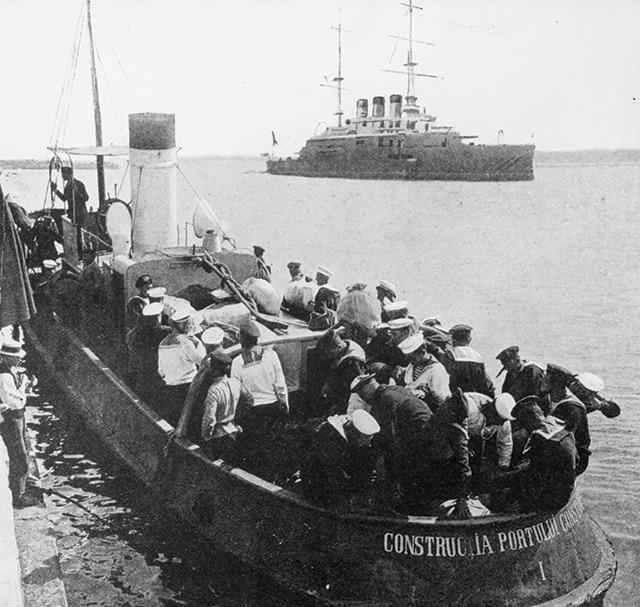In Focus: Mutiny on the Potemkin
Roger Hudson looks at an episode that inspired one of the greatest films ever made.
 Crew members of the Russian battleship Potemkin come ashore on a tugboat in Constanta harbour on the Romanian Black Sea coast after surrendering in July 1905. The battleship can be seen in the background and shortly she will settle in the water, half sunk, because the crew’s last act has been to open her seacocks.
Crew members of the Russian battleship Potemkin come ashore on a tugboat in Constanta harbour on the Romanian Black Sea coast after surrendering in July 1905. The battleship can be seen in the background and shortly she will settle in the water, half sunk, because the crew’s last act has been to open her seacocks.
Russia has been in a deeply disturbed state since the start of the year, brought on by her defeats in the Russo-Japanese War being fought in Manchuria. At the end of May the Russian Baltic fleet eventually reached the Far Eastern war zone, only to be wiped out at the Battle of Tsushima. The Black Sea fleet, already denuded of its best officers and men, now feared it would be ordered to follow. On June 24th 40 sailors suspected of being mutinous were taken off the Potemkin. On June 27th crew members refused to eat maggoty meat and then thought they were going to be shot as mutineers. They turned on their officers, killing seven of them, including the captain, before sailing into Odessa. Martial law had just been declared there because of fighting between strikers, police and soldiers. When the mutineers went ashore, the violence got worse. After firing the odd shell into the city, the battleship went to sea on June 30th, where she was confronted by a squadron from the Black Sea fleet, which chose not to fire on her, probably because the officers feared mutiny might also break out on their ships. The battleship St George did briefly mutiny, but then the officers and petty officers regained control and ran her aground. On July 2nd Potemkin arrived in Constanta for the first time but the Romanians would not sell her supplies, so she went back to Theodosia in the Ukraine. There a party of her sailors, trying to hijack coal barges for refuelling, was ambushed and 22 out of 30 failed to return. On July 8th she was back in Constanta, where she surrendered.
Mutinies and violence continued across Russia, culminating in a general strike in October, which forced the tsar to concede the principles of freedom of speech, conscience and association. However, as Trotsky said, Nicholas II had granted everything and given nothing and the revolt was soon crushed. The Potemkin episode was quickly mythologised by the revolutionaries, but its real transformation had to wait until the 27-year-old Latvian Sergei Eisenstein made the film Battleship Potemkin in 1925. He pared the story down to five episodes covering a mere three days, June 27th to 30th. Of these, it is the ‘Odessa Steps’ sequence that resonates, with its rows of boots marching down them, the bespectacled old lady wounded in the face, the baby’s pram bouncing down, the mother climbing up with her dead child in her arms. Eisenstein justified ending the film with ‘the Rendez-vous with a Squadron’ because, as he wrote, this was the point at which the story ‘had become an asset to the Revolution’.
As for the real-life ship, she was salvaged and renamed the Panteleimon, only to be scuttled again in 1919 during the Civil War by White forces in Sevastopol. Most of the 1905 crew stayed in Romania; some of those who went back to Russia were executed, including the leading mutineer, Afanasi Matuschenko; 32 went to Argentina. The last survivor, Ivan Beshoff, died in 1987, aged 102, after running a fish and chip shop in Dublin for many years.




